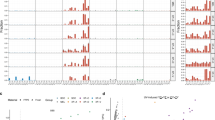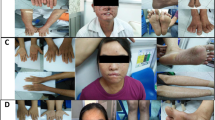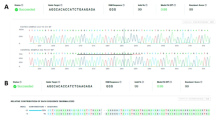Abstract
The xeroderma pigmentosum group D (XPD) helicase subunit of TFIIH functions in DNA repair and transcription initiation1,2. Different mutations in XPD give rise to three ultraviolet-sensitive syndromes: the skin cancer-prone disorder xeroderma pigmentosum (XP), in which repair of ultraviolet damage is affected; and the severe neurodevelopmental conditions Cockayne syndrome (CS) and trichothiodystrophy (TTD). In the latter two, the basal transcription function of TFIIH is also presumed to be affected3,4,5. Here we report four unusual TTD patients with fever-dependent reversible deterioration of TTD features such as brittle hair. Cells from these patients show an in vivo temperature-sensitive defect of transcription and DNA repair due to thermo-instability of TFIIH. Our findings reveal the clinical consequences of impaired basal transcription and mutations in very fundamental processes in humans, which previously were only known in lower organisms.
This is a preview of subscription content, access via your institution
Access options
Subscribe to this journal
Receive 12 print issues and online access
$209.00 per year
only $17.42 per issue
Buy this article
- Purchase on SpringerLink
- Instant access to full article PDF
Prices may be subject to local taxes which are calculated during checkout




Similar content being viewed by others
References
Schaeffer, L. et al. The ERCC2/DNA repair protein is associated with the class II BTF2/TFIIH transcription factor. EMBO J. 13, 2388–2392 (1994).
Drapkin, R. et al. Dual role of TFIIH in DNA excision repair and in transcription by RNA polymerase II. Nature 368, 769–772 (1994).
Vermeulen, W. et al. Three unusual repair deficiencies associated with transcription factor BTF2 (TFIIH): evidence for the existence of a transcription syndrome. Cold Spring Harb. Symp. Quant. Biol. 59, 317–329 (1994).
Bootsma, D., Kraemer, K.H., Cleaver, J.E. & Hoeijmakers, J.H.J. Nucleotide Excision Repair Syndromes: Xeroderma Pigmentosum, Cockayne Syndrome and Trichothiodystrophy 245–274 (McGraw-Hill, New York, 1998).
Coin, F., Bergmann, E., Tremeau-Bravard, A. & Egly, J.M. Mutations in XPB and XPD helicases found in xeroderma pigmentosum patients impair the transcription function of TFIIH. EMBO J. 18, 1357–1366 (1999).
Lehmann, A.R. Dual functions of DNA repair genes: molecular, cellular, and clinical implications. Bioessays 20, 146–155 (1998).
Taylor, E.M. et al. Xeroderma pigmentosum and trichothiodystrophy are associated with different mutations in the XPD (ERCC2) repair/transcription gene. Proc. Natl. Acad. Sci. USA 94, 8658–8663 (1997).
de Laat, W.L., Jaspers, N.G. & Hoeijmakers, J.H.J. Molecular mechanism of nucleotide excision repair. Genes Dev. 13, 768–785 (1999).
Lindahl, T. & Wood, R.D. Quality control by DNA repair. Science 286, 1897–1905 (1999).
de Boer, J. et al. A mouse model for the basal transcription/DNA repair syndrome trichothiodystrophy. Mol. Cell 1, 981–990 (1998).
Kleijer, W.J., Beemer, F.A. & Boom, B.W. Intermittent hair loss in a child with PIBI(D)S syndrome and trichothiodystrophy with defective DNA repair-xeroderma pigmentosum group D. Am. J. Med. Genet. 52, 227–230 (1994).
Takayama, K. et al. Defects in the DNA repair and transcription gene ERCC2 (XPD) in trichothiodystrophy. Am. J. Hum. Genet. 58, 263–270 (1996).
Hansen, L.K., Wulff, K. & Brandrup, F. Trikotiodystrofi. Ugeskr Laeger 155, 1949–1952 (1993).
Broughton, B.C., Steingrimsdottir, H. & Lehmann, A.R. Five polymorphisms in the coding sequence of the xeroderma pigmentosum group D gene. Mutat. Res. 362, 209–211 (1996).
Satoh, M.S. & Hanawalt, P.C. Competent transcription initiation by RNA polymerase II in cell-free extracts from xeroderma pigmentosum groups B and D in an optimized RNA transcription assay. Biochim. Biophys. Acta 1354, 241–251 (1997).
Vermeulen, W. et al. Sublimiting concentration of TFIIH transcription/DNA repair factor causes TTD-A trichothiodystrophy disorder. Nature Genet. 26, 307–313 (2000).
Johnson, R.T. & Squires, S. The XPD complementation group. Insights into xeroderma pigmentosum, Cockayne's syndrome and trichothiodystrophy. Mutat. Res. 273, 97–118 (1992).
Le Page, F. et al. Transcription-coupled repair of 8-oxoguanine: requirement for XPG, TFIIH, and CSB and implications for Cockayne syndrome. Cell 101, 159–171 (2000).
Hanawalt, P.C. DNA repair. The bases for Cockayne syndrome. Nature 405, 415–416 (2000).
Citterio, E., Vermeulen, W. & Hoeijmakers, J.H.J. Transcriptional healing. Cell 101, 447–450 (2000).
Powell, B.C. & Rogers, G.E. in The Keratinocyte Handbook (eds. Leigh, E.M. & Lane, E.B.) 401–436 (Cambridge University Press, Cambridge, 1994).
Zinkham, W.H., Liljestrand, J.D., Dixon, S.M. & Hutchison, J.L. Observations on the rate and mechanism of hemolysis in individuals with Hb Zurich [His E7(63)β leads to Arg]: II. Thermal denaturation of hemoglobin as a cause of anemia during fever. Johns Hopkins Med. J. 144, 109–116 (1979).
Bruce, D., Perry, D.J., Borg, J.Y., Carrell, R.W. & Wardell, M.R. Thromboembolic disease due to thermolabile conformational changes of antithrombin Rouen-VI (187 Asn→Asp). J. Clin. Invest. 94, 2265–2274 (1994).
Klein, B., Pastink, A., Odijk, H., Westerveld, A. & van der Eb, A.J. Transformation and immortalization of diploid xeroderma pigmentosum fibroblasts. Exp. Cell. Res. 191, 256–262 (1990).
Sijbers, A.M. et al. Mutational analysis of the human nucleotide excision repair gene ERCC1. Nucleic Acids Res. 24, 3370–3380 (1996).
Acknowledgements
We thank D. Bootsma and F.A. Beemer for support; M. Stefanini for discussions; and J.-M. Egly for materials. This work was supported by the Dutch Cancer Society, EEC, NIH, the Research Institute for Diseases in the Elderly, funded by the Ministry of Education & Science and the Ministry of Health, Welfare and Sports, through the Netherlands Organization for Scientific Research (NWO), a SPINOZA award and the Louis Jeantet Foundation.
Author information
Authors and Affiliations
Corresponding author
Rights and permissions
About this article
Cite this article
Vermeulen, W., Rademakers, S., Jaspers, N. et al. A temperature-sensitive disorder in basal transcription and DNA repair in humans. Nat Genet 27, 299–303 (2001). https://doi.org/10.1038/85864
Received:
Accepted:
Issue Date:
DOI: https://doi.org/10.1038/85864
This article is cited by
-
Dynamic conformational switching underlies TFIIH function in transcription and DNA repair and impacts genetic diseases
Nature Communications (2023)
-
Understanding nucleotide excision repair and its roles in cancer and ageing
Nature Reviews Molecular Cell Biology (2014)
-
Phenotype-specific adverse effects of XPD mutations on human prenatal development implicate impairment of TFIIH-mediated functions in placenta
European Journal of Human Genetics (2012)
-
Disorders of nucleotide excision repair: the genetic and molecular basis of heterogeneity
Nature Reviews Genetics (2009)
-
UVH6, a Plant Homolog of the Human/Yeast TFIIH Transcription Factor Subunit XPD/RAD3, Regulates Cold-stress Genes in Arabidopsis thaliana
Plant Molecular Biology Reporter (2009)



